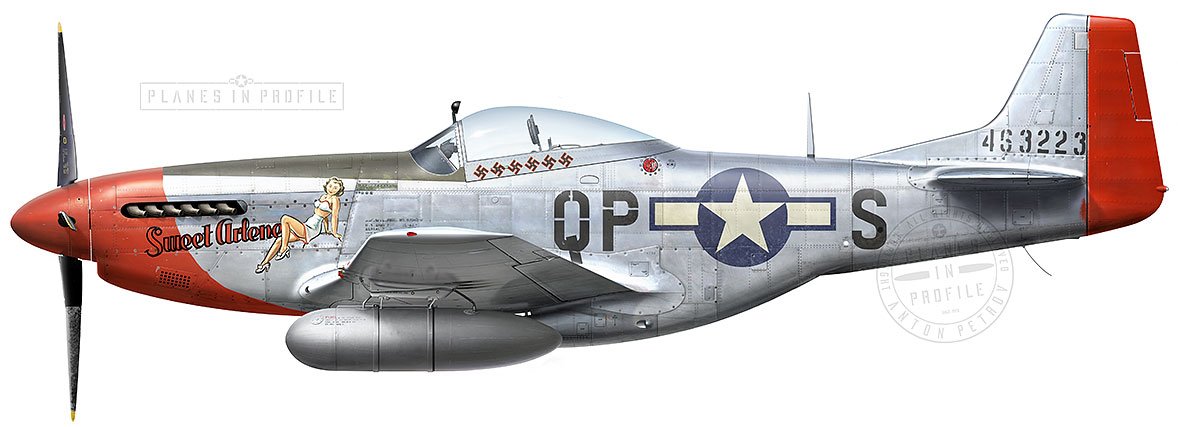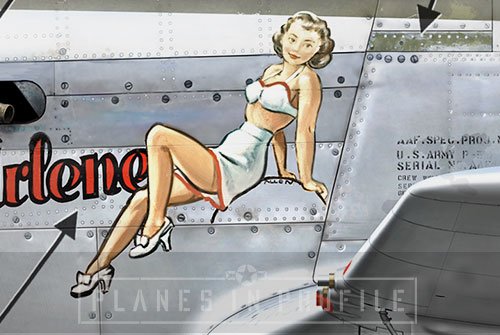Bowers’s “Sweet Arlene”
NORTH AMERICAN, P-51D-20 (MUSTANG), SERIAL NUMBER 44-63223
334th Fighter Squadron, 4th Fighter Group ‘Debden Eagles’, 8th Air Force, Debden (Essex, England), Spring 1945.
Flown by 1st Lt. Arthur Reed Bowers
The image above shows 44-63223 as it appears in a photo which was presumably taken after 16th of April 1945.
Arthur Bowers was assigned to the 4th Fighter Group’s 334th Squadron on November 16th, 1944 and he remained serving in that unit until the end of the war. The airplane that was assigned to him was a P-51D Mustang serial number 44-63223, which was give the name “Sweet Arlene” [1]. Bowers flew 30 missions, most of them in this aircraft, and though he didn’t score any aerial victories he became a “strafing ace” destroying 6 enemy aircraft on the ground. These victories were:
On the 25th of February, during a sweep of the Dessau area, a section of the 334th FS found an airfield near Rohrensee with 60 enemy airplanes camouflaged by the freshly cut branches. The Mustangs attacked, making several successful passes and destroying a number of enemy planes on the ground, including an Me-262 jet fighter which was coming in for the landing. 1Lt Arthur Bowers was credited with destroying 3 airplanes in that attack, a Fw-190, a Bf-110 and a Me-410, all on the ground.
A month later, during a fighter weep of the Worms-Plauen-Weimar-Crailsheim area on the 26th of March, Sweet Arlene was hit by German 20mm and 40mm flack shells, as well as small arms fire. This happened Northeast of Erlangen and the hits blasted a five-inch hole in one of Sweet Arlene’s ailerons and eight holes through the canopy, wounding 2Lt Arthur Bowers in the neck. Luckily for Bowers his wounds were superficial and so were Sweet Arlene’s, so Bowers was able to fly his damaged warbird back to his unit’s airfield.
On 16th of April, the 334th FS attacked Gabligen airfield, devastating it. 2Lt Bowers again claimed 3 ground kills (two fighters and one bomber) during this attack[2]
Noteworthy Visual Characteristics
1) The sweped-back red nose colouring was the late-war identification marking of airplanes of the 4th Fighter Group.
2) The plane had no exhaust stack shrouds.
3) Bowers airplane was christened ‘Sweet Arlene’. The nose art is based on a photo of Bowers’s wife. It was painted by S/Stg Donald E. Allen who signed his name under the black line that “Arlene” is sitting on.
4) One of the panels on the side of the nose looks like it was a different colour. It was possibly replaced from another P-51, if not touched up with paint.
5) The 6 swastikas represent Bowers 6 ground kills. It appears that the swastikas had a thin red outline.
Sometimes ground kill markings were differentiated from aerial kill markings by a tiny letter ‘G’ for ‘Ground’ painted in the centre of the swastikas. It might even be possible that the victory markings on Bowers’ plane also had these painted on.
6) The flare gun hole appears to have been plugged.
7) “QP” was the identification code of the 334th Fighter Squadron.
8) “S” was the identification code of Bowers’s plane.
9) 463223 indicates the serial number of the airplane (44-63223).
10) The red rudder was an identification marking of the 334th Fighter Squadron.
11) On Patreon.
12) On Patreon.
13) It appears that there was no antenna wire on this plane.
14) The mirror was on the windscreen (not on the moving part of the canopy).
15) The top of the nose was painted with non-glare paint of olive drab colour.
FOOTNOTES
[1] https://www.americanairmuseum.com/archive/person/arthur-reid-bowers
[2] Based on the information from the book ‘4th Fighter Group, ‘Debden Eagles’’ by Chris Bucholtz, published by Osprey Publishing in 2008, pages 111-126, PDF e-book ISBN:978 1 84603 809 9
SUMMARY OF LINKS TO THE REFERENCE IMAGES AND VIDEOs
https://www.americanairmuseum.com/archive/media/media-21132jpeg
https://www.americanairmuseum.com/archive/aircraft/44-53223
https://www.americanairmuseum.com/archive/media/media-15042jpeg
https://www.americanairmuseum.com/archive/media/media-15515jpeg
All the work presented on this page is subject to updates and revisions in the light of new information which might present itself. If you have any new information relevant to this page or disagree with anything that's presented here, then please contact me through the Planes in Profile Facebook page to help make the content of this page more accurate. Thanks:)




